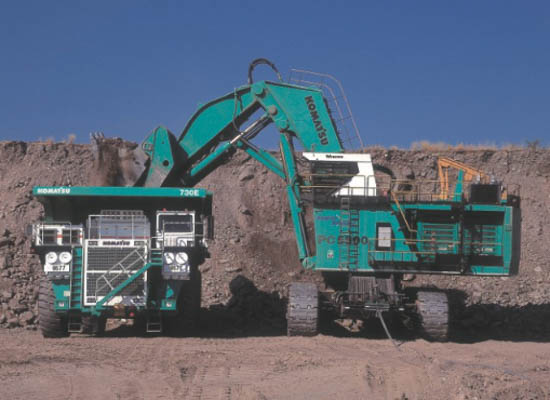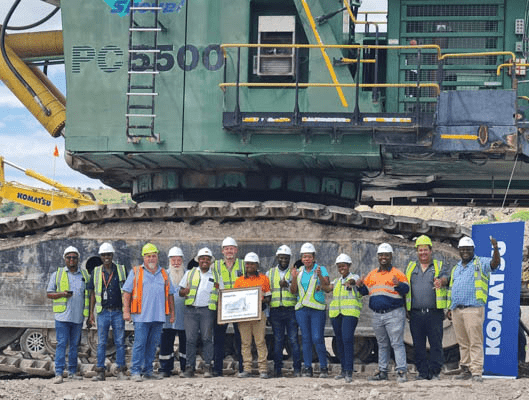3 min read
Komatsu recognized by CDP as the “A List” with the highest rating for climate change and water
- Press release,Company,Sustainability
6 min read
.png)
November 22, 2023 -- Komatsu super shovel PC5500-6E still operational since 2002 at Foskor mine in Limpopo.
The secret to the success of the Komatsu Super Shovel PC5500-6E at the Foskor mine in Limpopo – apart from its intrinsic design, ‘genetics’ and engineering – is the strength of the OEM and customer relationship, Bongani Maseko (BM), mine manager tells Sharyn Macnamara from African Mining Market publication.
The Komatsu PC5500-6E – with its electric over hydraulic drive unit with no engines – was delivered to the Foskor mine near Phalaborwa in December of 2002. This opencast mine in South Africa’s Limpopo Province, yields up to 2.6 million tons per annum of phosphate rock concentrate after processing 35 million tons of ore per annum, but not without the help and the hard graft of this monster machine, which has hit an operational milestone of over 100 000 hours – and is believed to be the only PC5500 in Africa, to do so in a hard rock environment.
The machine has three counterparts – one in Russia, one in Zambia and one in Chile that have delivered 100 027, 95 992 and 92 264 hours respectively – as at the time of celebrations on the Foskor mine in March this year. Named after the plant it has worked at for over 20 years, ‘2033’ is a machine to be reconned with – with an operating weight from 533-552 tons, in shovel configuration and a bucket capacity of 29m³. Paired with Komatsu 730E Electric Drive trucks with a 190-ton capacity, this machine has delivered year after year.
SM: Interviewer, Sharyn Macnamara from African Mining Market
BM: Komastu Mine Manager, Bongani Maseko
SM: With the PC5500 still operational at over 100 000 hours, at an average availability of 93%, and having moved 113 700 200 tons in a hard rock environment, what do you believe the secret to the success of this machine at the mines?
BM: There are a couple of aspects involved – from the design and engineering prowess of the machine itself to the very strict maintenance schedule and more – however, the main ingredient, I believe, is the strong relationship that Foskor Mine and the original equipment manufacturer (OEM), Komatsu, have built over the years. That is the starting point of our success. With the OEM being on site, we have been able to call on the supplier’s expertise at a moment’s notice and are able to manage scheduled maintenance and breakdowns timeously.
This strategic relationship was entered into on the basis of a repair and maintenance programme (RAMP) contract since delivery of the machine in December 2002. Komatsu has taken full responsibility for the well-planned maintenance schedule of the machine – delivered and adhered to by dedicated, expert personnel. There is always a daily inspection before 2033 goes into action. The expert technicians are also on call 24/7 should the machine so much as ‘sneeze or cough’. Weekly scheduled maintenance is also a must, and with components in stock and on hand when change outs are due, this is yet another advantage for the operation offered by the OEM RAMP contract.
SM: Understanding that a rigorous, reliable, strict maintenance schedule and a stringent lubrication programme based on the 5 R’s – the right product, the right quantity, applied to the right place at the right time, with of course the right attitude – is key to the optimisation of a machine like this; and apart from the intrinsic ‘genetics’, what else, in your opinion, has had a role to play in the longevity it has displayed?
BM: Training the operators to manage a powerful machine like the PC5500 is a vital factor in the mix – the OEM’s input is critical when it comes to setting the standard here, so Komatsu is always involved in training our professional operators.
Optimal blasting and good fragmentation are of course also key to enhance the performance of the machine. None of these factors work in isolation to create the ideal operating conditions – all round, clear and streamlined communication between all parties is also key! We have three eight-hour shifts in a day, and when one operator leaves, there is always a thorough hand over procedure between shifts, and operators are debriefed on any concerns or issues from the previous shift. The beauty of having a RAMP contract in place is the fact that the maintenance team is available around the clock and can be alerted of any issues immediately too.
Also, the loading areas must be prepared properly to avoid damage to the machine. The operator must be afforded full view of his working environment. So, when the machine is busy loading, supervisors are close at hand, giving guidance and direction and assisting in the observation of blind spots with two-way radio connectivity.
SM: Has the machine experienced an overhaul of any nature in its life cycle?
BM: Apart from regular maintenance and required component change outs, the machine has not had an overhaul. In fact, the machine has exceeded our expectations with an average availability of 93%. We also have a sister shovel, ‘2035’, with the same specifications in successful operation, in parallel.
SM: How much longer do you expect this machine to last and what are the plans going forward?
We expect 2033 to retire some time in 2024. However, 2033 has stood the test of time in exceptionally rugged conditions and will always have a place at Foskor – we plan to touch this mammoth machine up with a lick of paint and maintain it as a show piece, which will have pride of place at the mine for posterity.
 Delivered in December 2002, ‘2033’ is a machine to be reckoned with – with an operating weight from 533-552 tons, in shovel configuration and a bucket capacity of 29m³.
Delivered in December 2002, ‘2033’ is a machine to be reckoned with – with an operating weight from 533-552 tons, in shovel configuration and a bucket capacity of 29m³.
Source: African Mining Market by Sharyn Macnamara posted on 1 November 2023.

